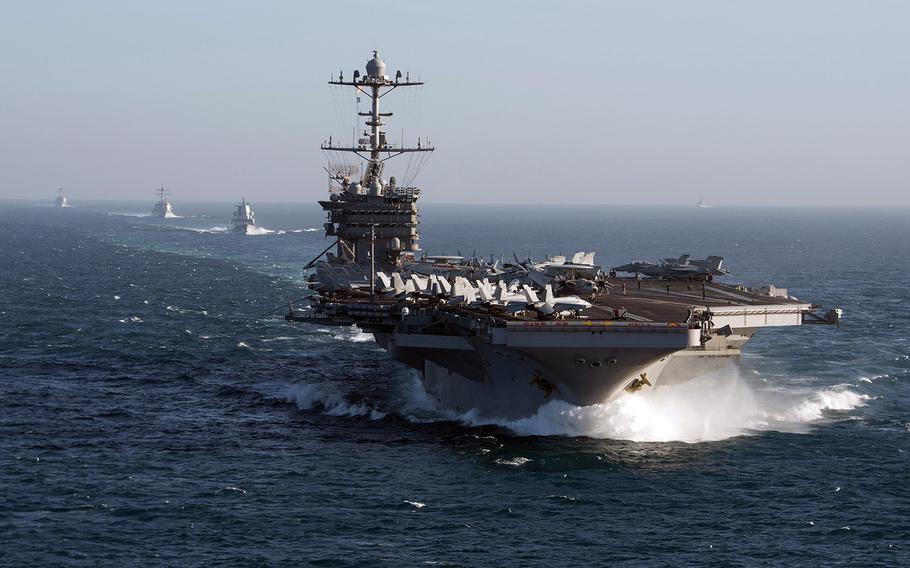Aircraft carrier USS Truman to deploy next week to Middle East
By Caitlyn Burchett – Stars and Stripes • September 20, 2024

WASHINGTON – The aircraft carrier USS Harry S. Truman and a force of 6,5000 sailors will deploy next week on a mission that is expected to take the warship’s strike group into the Middle East, Navy officials announced Friday. The Truman and the other ships in its strike group will leave early next week from Naval Station Norfolk, Va. and Naval Station Mayport, Fla., according to U.S. Fleet Forces. The carrier strike group includes Carrier Air Wing 1 with nine aviation squadrons, the Ticonderoga-class, guided-missile cruiser USS Gettysburg, and two Arleigh Burke-class, guided-missile destroyers, the USS Stout and the USS Jason Dunham. The strike group has spent recent months training in the western Atlantic Ocean for a rare, pre-planned deployment expected to take the ship into the hostile environment of the Red Sea. U.S. sailors and allied nations have fought almost daily for months to down drones and missiles launched by Iran-backed Houthi rebels from Yemen as tensions in the Middle East have raged on for nearly a year. The aircraft carrier USS Gerald R. Ford in October 2023 was ordered to sail to the region after a deadly attack on Israel by Hamas militants. Following the attack, Iran and proxy forces have targeted maritime merchants and shipping traffic in the Red Sea. In the past year, Defense Secretary Llyod Austin has twice ordered two carriers to the region, as well as bolstering U.S. forces with an amphibious ready group and a nuclear-powered submarine. The aircraft carrier USS Dwight D. Eisenhower joined the Ford in the winter before the Ford returned to Norfolk. The Eisenhower completed an eight-month deployment to the region in July, being relieved by San Diego-based carrier USS Theodore Roosevelt. In August, Austin ordered the extension of the Roosevelt as well as directed the USS Abraham Lincoln, also a West Coast-based carrier, to the Red Sea. The Roosevelt and the Lincoln’s time in the region overlapped by about three weeks before the Roosevelt was ordered to return home. The Lincoln and its strike group are still in the region. The Truman will transit to the Middle East with a strike force of 90 aircraft, including F/A-18 Super Hornet fighter jets, E-2D Hawkeye command and control aircraft, E/A18 Growler electronic warfare jets, and MH-60 Seahawk helicopters. “They know that they’re most likely going to be entering a weapon engagement zone,” Adm. Daryl Caudle, the leader of Navy Fleet Forces Command, said during a rare Miami Fleet Week appearance in May. The Fleet Week appearance was wedged into training ahead of what is expected to be an intense deployment. “I believe, personally, that puts higher stakes on why what we do [in training] is so important,” Caudle said in May. “For this group, this [deployment] is not with the mindset that they’re just going to go drill holes in the water somewhere — this is, ‘We’re going to be employed for combat.’” CAITLYN BURCHETT Caitlyn Burchett covers defense news at the Pentagon. Before joining Stars and Stripes, she was the military reporter for The Virginian-Pilot in Norfolk, Va. She is based in Washington, D.C.
Read more at: https://www.stripes.com/branches/navy/2024-09-20/truman-aircraft-carrier-deploy-middle-east-15244264.html?utm_source=Stars+and+Stripes+Emails&utm_campaign=Daily+Headlines&utm_medium=email&utm_source=Stars+and+Stripes+Emails&utm_campaign=94eba747b1-Newsletter+-+Daily+Headlines&utm_medium=email&utm_term=0_0ab8697a7f-94eba747b1-296803338
Source – Stars and Stripes























